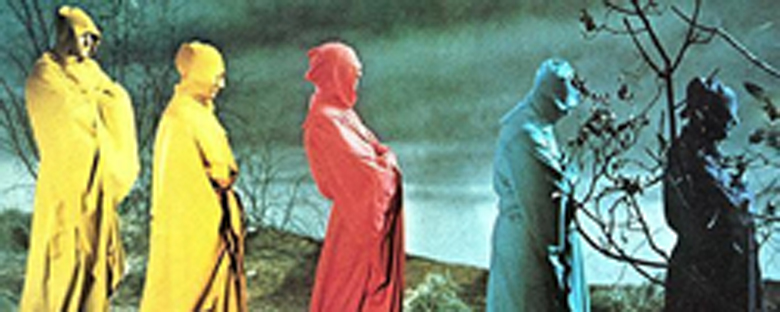Reviews
Roger Corman
UK/USA, 1964
Credits
Review by Leo Goldsmith
Posted on 02 October 2004
Source MGM DVD
Related articles
features: October: 31 Days of Horror
“And Darkness and Decay and the Red Death held illimitable dominion over all.” Such is the happy conclusion of Edgar Allan Poe’s story and Roger Corman’s film of The Masque of the Red Death: the primacy of death, inexorable in any color. In adapting Poe’s short story to the screen, Corman adds much material (a romance, some Satanism, and a subplot with a dwarf) but never loses sight of Poe’s final invocation of death’s “illimitable dominion.”
The process of Roger Corman’s eight adaptations of Poe’s works follows a basic pattern: add a romantic subplot where one is lacking, redress the same “haunted castle” set, and hire Vincent Price in the creepiest role. For Masque, Corman had much to add. Poe’s story is very short, barely establishing the character of Prince Prospero, his sadism, and his decision to seclude himself in his castle while the Red Death ravages the countryside without. (In this way, the film offers a macabre alternative to the revelry of Boccaccio’s Decameron.) Corman’s innovation is to recast the “bold and robust” Prospero of Poe’s story as the perverse and simpering Satanist played by Price.
The inclusion of the Satanism (and its opposite) in the film adds much to Poe’s story without changing its basic moral. Price’s Prospero is a worshipper of the “Lord of Flies,” and his nemesis (and sometime victim) is the pure, innocent villager Francesca, whom he has brought to his castle in order to corrupt. Their dialogue becomes a contest of faith: the god of love and compassion versus the god of “realism” (as Prospero explains, cruelty is merely a part of life). Of course, this surprisingly civil dialectic is interrupted and extinguished by the presence of the Red Death, a third force which (although it saves Francesca and her love) effectively puts an end to any foolish questions of faith in God or Satan.
As Corman makes plain (and Poe implicitly states), “Death has no master” and is content to kill everybody at some point. The insidious red-cloaked figure of Death is seen at the beginning of the film offering deliverance to an old woman – then he subjects her to an unpleasant plague-ridden demise. Once Prince Prospero has been similarly dispatched, bleeding from the face, Death is seen calmly playing cards with a cute little girl (whom he hasn’t yet killed) and chatting about the equivocal nature of taking lives with his “brothers.” (These are similarly cloaked figures presumably embodying the Yellow Death, Blue Death, Orange Death, and so on, all luridly captured with Nicholas Roeg’s over-saturated cinematography). The philosophical import of this chat, such as it is, is that death is a mere inevitable fact, whatever moral value one wants to put on it. The film thus avers the supernatural, but conspicuously resists any sense of divine justice or satisfaction.
We don’t do comments anymore, but you may contact us here or find us on Twitter or Facebook.



